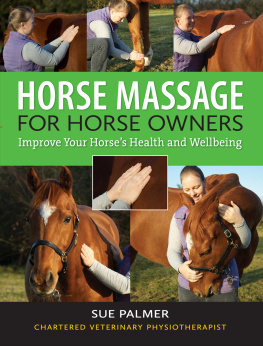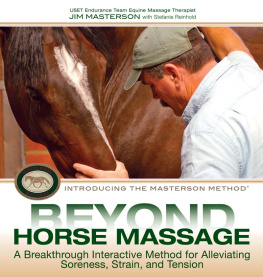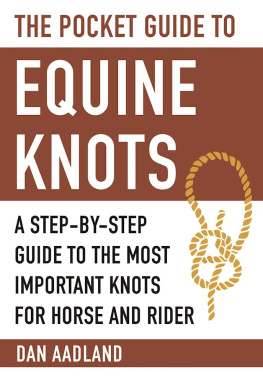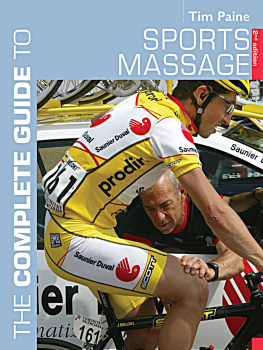CONTENTS
Introduction
Around the world, there are more horses under saddle now than at any time since the turn of the twentieth century. Because of the significant numbers of horses being used for work, competition, show, and pleasure, we are seeing an increased incidence of equine muscle problems, due in part to insufficient warm-ups and cool-downs, ill-fitting equipment, too much time spent in the stall, or some combination of these factors.
Disappointed by the diminished performance levels of their horses, owners and trainers frequently turn to veterinarians and farriers for advice, as well they should. If its determined that impaired performance is not due to an injury, a fault in conformation, or an obvious mechanical defect, muscle soreness may be the problem. Because muscle soreness tends to wax and wane depending on a horses workload and level of training, definitive diagnosis can be tricky.
Rarely does muscle soreness go away by itself, so our goal here is to help you recognize signs of trouble, determine what areas are sore, and seek out possible causes. In addition, we provide you with some basic techniques for stretching and massaging your horse. In the event of a chronic problem, we note when the services of a professional equine massage therapist might be beneficial and how to go about finding one.
Regular stretching and massage, in conjunction with proper care and exercise, can help keep your horse sound and healthy while maintaining his performance level and even improving his attitude. After a soft-tissue injury, regular massage minimizes scar tissue and breaks up adhesions that have the potential to create a chronic limp or shorten a stride. Massage also improves circulation, helping to flush harmful waste products such as lactic acid from the muscles and enhancing the effect of the immune system due to increased blood flow. With all these benefits, its no wonder horses welcome this tried-and-true, hands-on approach.
Reminder
Massage therapy is not a substitute for proper veterinary care. If your horse is injured or shows signs of distress, call your veterinarian immediately and have your horse thoroughly examined before contacting a certified equine massage therapist.
Step-by-Step Equine Massage
How to Relieve Soreness, Improve Flexibility, and Keep Your Horse Sound
Candy Sipka, C.E.S.M.T.
Cherry Baldridge, L.E.S.M.T.
What Do Muscle Problems Look Like?
Muscle problems can and do present in a variety of ways. Your horse might alert you to muscle soreness or pain if he:
 Refuses to use specific gaits or leads
Refuses to use specific gaits or leads
 Exhibits stiffness or loss of flexibility in the neck or back
Exhibits stiffness or loss of flexibility in the neck or back
 Favors short strides
Favors short strides
 Chooses to stand parked out or camped under
Chooses to stand parked out or camped under
 Is unwilling to stand still when tied
Is unwilling to stand still when tied
 Doesnt like to back or refuses to back (either in hand or under saddle)
Doesnt like to back or refuses to back (either in hand or under saddle)
 Reacts to the girth/cinch being tightened or to being tacked up
Reacts to the girth/cinch being tightened or to being tacked up
 Finds brushing annoying and standing to be shod difficult
Finds brushing annoying and standing to be shod difficult
Physical signs of muscle soreness may include atrophy of the back muscles, distended abdominal muscles, sunken stifles, and rigidity. If you suspect a muscle problem, have your horse examined by a veterinarian and possibly by a farrier before consulting an equine massage therapist, just to be sure that nothing else is physically wrong.
Determining What Is Sore
Like humans, all horses will experience some level of muscle soreness on occasion, but many owners and trainers have no inkling that something is wrong until it becomes outwardly apparent in a horses grumpy mood or noticeable lameness. To be fully aware of your horses condition, make a point of checking him regularly. A good time for a quick exam is during a grooming session or just before saddling up.
1. Be vigilant. Examine your horse for cuts, bumps, and muscle soreness. A horse with healthy muscle tone looks soft and round, the muscles rippling under the skin as he moves. If peaks and valleys in muscle tone are visible, his muscles are tight and possibly sore.
2. Feel your horses muscles. Begin by gently running your hands over the horses topline, so he becomes accustomed to your touch. As you do this, ask yourself how the muscles feel. Are they soft and pliable as they should be, or are they hard and stiff?
Being careful to apply no more pressure than the horse can tolerate, press more strongly with your fingertips, this time feeling for the deep muscles. Are the muscles soft and pliable, or are they hard and stiff? Examine your horse from front to back and from top to bottom, noting any areas that feel hard or that your horse finds uncomfortable.
3. Observe your horse. As you examine your horse, watch for his reactions. If he flinches or moves away at even the slightest touch, then he is quite sore and the superficial muscles are involved. If your horse responds to slightly deeper pressure and you feel tension there, then the medial, or middle, muscles are affected. Youll need to use slightly more pressure to evaluate the deep muscles of the neck, shoulders, and hindquarters, which also feel tight and hard if there is a problem.
How Can I Prevent Muscle Soreness?
As more owners and trainers are being educated about muscle soreness, they want to know how to prevent it. Simply put, muscle soreness cant always be prevented, but you can minimize its likelihood by thoroughly warming up and cooling down your horse; ensuring the quality, fit, and proper placement of all tack, especially the saddle (see below); exercising your horse regularly; and giving the horse as much turnout as possible every day.
In addition, know your horse, and know how he moves and stands. Watch for any uncharacteristic reactions on your horses part, particularly when tacking up. Take a few minutes a day to run your hands over your horse, feeling his muscle tone and watching for signs of discomfort. Your horse will let you know if a spot is sore, and the sooner you find it, the more quickly you can address it. By keeping your horse comfortable and relatively pain free, youll help his performance and improve his overall fitness.
Good Saddlefitting Can Prevent Soreness
Saddle quality and fit are critical to a horses comfort. If a saddle is not structurally sound and does not fit him well, the horse will learn to associate the saddle with pain and wont perform to his full potential. A narrow saddle tree, excessive padding, and improper saddle placement are all common causes of muscle soreness and discomfort in horses, so assessing saddle fit is an essential part of the evaluation process. Begin by checking the balance and stability of the saddle, then check its size, fit, and position. If you discover a problem with the saddle, correcting it is in the best interest of your horses health.
Saddle Balance
Checking the saddle for structural problems before placing it on the horse is an important first step. Any saddle can be evaluated as described here, although Western saddles are somewhat more difficult to work with because of their greater weight and large size.







 Refuses to use specific gaits or leads
Refuses to use specific gaits or leads